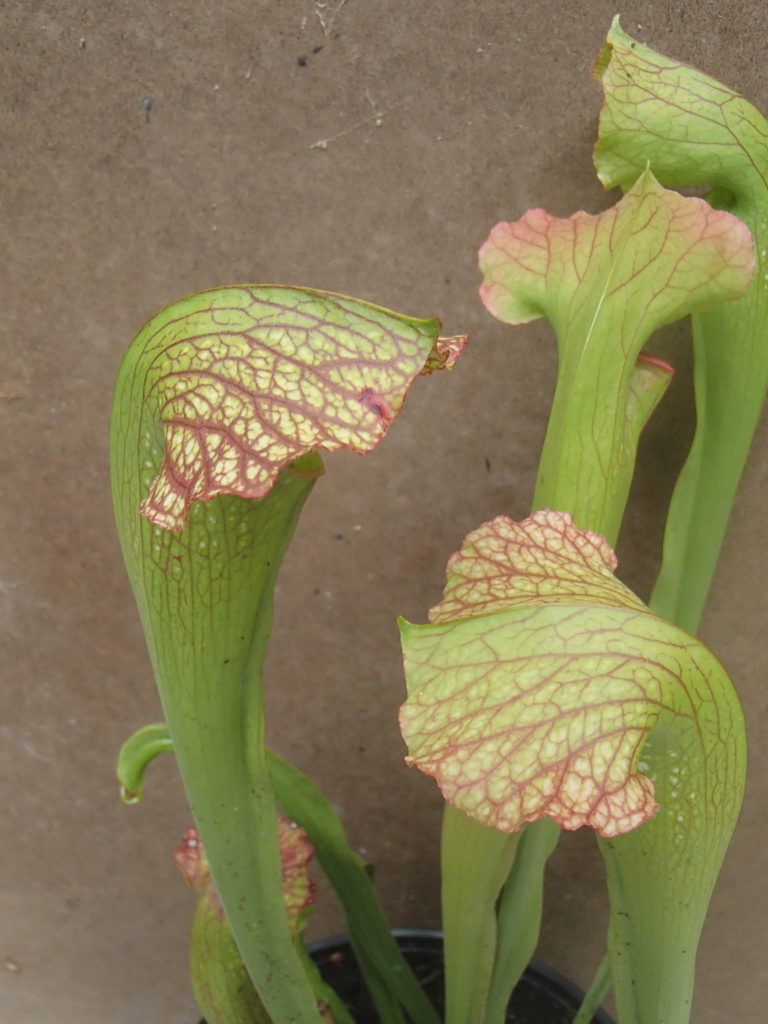‘Mardi Gras’ is one of the most beautiful of the pitcher plants — an herbaceous perennial presenting as a sturdy clump of modified leaves (pitchers) averaging 1′ tall. The pitcher is an insect trap, consisting of an undulating, often flared, frilly hood with a striking pattern of deep rose veins and white or pale green interveinal spots atop a hollow, green throat or tube. Like all pitcher plants, ‘Mardi Gras’ thrives in full sun. Red, fragrant flowers appear in the spring but the best show is the new pitchers emerging continuously throughout the growing season. Insects and spiders are attracted to and passively “captured” in the pitchers where their soft parts are digested and their exoskeletons accumulate through the season. Kids of all ages are fascinated to see the little bodies pile up in there. ‘Mardi Gras’ and other pitcher plants can easily be grown in containers in peatmoss and perlite or sand, watered with deionized water (to control salt accumulation). When winter dormancy occurs (the pitchers turn brown and dry out) they should be allowed to undergo some cold, and roots should be kept moist. In spring the old, full pitchers can be clipped off in anticipation of a new season of rampant carnivory. ‘Mardi Gras’, introduced by UNC botanists Larry Mellichamp and Rob Gardner, is a cross of two hybrids, the lineage is as follows: (Sarracenia leucophylla x purpurea) x (Sarracenia leucophylla x psittacina). All are North American. The USDA distribution map (see the link below) is for the genus Sarracenia.
NURSERY HOURS
Wednesday: 10-4 Thursday: 10-6 Friday-Saturday: 10-4 Sunday: 12-4
Sarracenia ‘Mardi Gras’

Key Info
Scientific Name: Sarracenia 'Mardi Gras'
Common Names: Mardi Gras
Family Names: Sarraceniaceae
Light Requirement: Full sun
Flower Color: Red
Additional Info
Habit: Sarracenias are clump-forming herbaceous perennials that grow as rosettes from a branching rhizome, forming colonies and containing fibrous roots 8-12 inches long along its length. The pitchers are modified leaves that (in addition to their function of photosynthesis) attract and entrap their insect prey by means of colorful presentation and nectar production (like flowers) and modifications to prevent escape. Wikipedia has a concise treatment of Sarracenia's entrapment mechanisms.
Height: 1'- 1.15'
Spread: 1.5'
Soil Conditions: Moist or wet, nutrient-poor, peaty, acidic soils.
Leaves: There is a festive look to this cultivar due to the bright patterning of rosy veins on white or pale green tissues of the hood and upper regions of the sturdy tube or trap, the lower parts of the trap being green. The pitchers, leaves modified to attract, capture, hold and digest animal prey, are 1 to 1.5 feet tall and the clump is equally wide, each pitcher a bit larger than the previous one through the growing season.
Flowers (or reproductive structures: Five maroon red petals hang down from inverted umbrella-like flowers with yellow interior parts, dangling from a leafless stalk at the same height as the pitcher.
Fruit: Each flower is followed by a dry 5-parted seed capsule that splits open along 5 seams at maturity (June/July) exposing small, papery, pear-shaped seeds. The seeds fall near the parent plant. Seeds of 'Mardi Gras' will not be true. Propagate by division.
Natural Distribution: Sarracenia live in any permanently moist site including swamps, lake edges, river banks, boggy pine forests, or other low-lying areas. They cannot live in permanently flooded areas, but survive well in areas that experience temporary seasonal floods and submersion. They cannot tolerate long-term drought.
USDA Hardiness Zone: 4 to 8
USDA Wetland Indicator Status in NC: OBL
Pollination: Bees, and other insects.
Wildlife Connections: Obtains nutrients (nitrate and phosphate) from insects. Insects and other tiny creatures are attracted by the nectar and coloration of the traps. The main prey of Sarracenias are ants, flies, wasps, bees, beetles, slugs and snails.
Propagation: A hybrid cross, 'Mardi Gras' is propagated by division.
